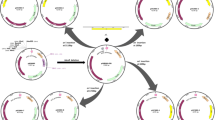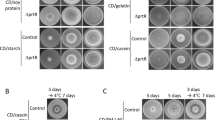Summary
Upon starvation, amoebae of the mutant strain HPX235 are unable to aggregate. Previous work has shown that this aggregateless character was associated with a nearly complete block in the production of the phosphodiesterase by these cells. Aggregation of the HPX235 amoebae can be induced with exogenous phosphodiesterase. In the present work, we show that both the aggregateless character and the block in phosphodiesterase production appear to result from the same recessive mutation, allocated to I.g.IV. Two other mutant strains displaying a comparable phenotype (HPX262 and HP594) were shown by complementation to belong to the same locus pdsA. Unlike wild type cells, the mutants of the locus pdsA cannot be induced to produce phosphodiesterase following treatment of the cells with exogenous cAMP, whether exogenous phosphodiesterase is present or not in the starvation buffer. It is concluded that pdsA is either the structural gene for the phosphodiesterase or a controlling element whose integrity is required for phosphodiesterase production. Mutations in pdsA share secondary effects among which the abnormally low production of the phosphodiesterase inhibitor. However, this effect can be overcome upon addition of exogenous phosphodiesterase, and most likely results from the lack of cAMP hydrolysis.
The late development is also affected in pdsA mutants. Aggregates formed in the presence of exogenous phosphodiesterase cannot culminate normally. This suggests that the level of cAMP hydrolysis also plays a role during the late stages of development of Dictyostelium discoideum.
Similar content being viewed by others
Abbreviations
- cAMP:
-
adenosine 3′,5′-cyclic monophosphoric acid
- l.g.:
-
linkage group
- PDE:
-
3′,5′-cAMP phosphodiesterase
References
Alcantara, F., Bazill, G.W.: Extracellular Cyclic AMP-phosphodiesterase accelerates differenciation in Dictyostelium discoideum. J. Gen. Microbiol. 92, 351–368 (1975)
Barra, J.: Synergie entre mutants d'agrégation de Dictyostelium discoideum. C.R. Acad. Sci. Paris 284, 689–692 (1977)
Brachet, P., Barra, J., Darmon, M., Barrand, P.: A phosphodiesterase-defective mutant of D. discoideum. In: Development and differentiation in cellular slime moulds Cappuccinelli and Ashworth, (eds.). pp. 125–134. Amsterdam: Elsevier North Holland 1977
Brachet, P., Dicou, L., Klein, C.: Inhibition of cell differentiation in a phosphodiesterase defective mutant of Dictyostelium discoideum. Cell Differ. 8, 255–265 (1979)
Brooker, G., Thomas, C.J., Appleman, M.M.: The assay of adeno sine 3′5′ cyclic monophosphate and guanosine 3′5′ cyclic monophosphate in biological materials by enzymatic radioisotopic displacemen. Biochemistry 7, 4177–4181 (1968)
Chang, Y.Y.: Cyclic 3′-5′ adenosine monophosphate phosphodiesterase produced by the slime mold Dictyostelium discoideum. Science 161 57–59 (1968)
Coukell, M.B.: Parasexual genetic analysis of aggregation deficient mutants of Dictyostelium discoideum. Mol. Gen. Genet. 142, 119–135 (1975)
Darmon, M., Barra, J., Brachet, P.: The role of phosphodiesterase in aggregation of D. discoideum. J. Cell Sci. 31, 223–243 (1978)
Darmon, M., Brachet, P., Pereira da Silva, L.H.: Chemotactic signals induce cells differentiation in Dictoystelium discoideum. Proc. Natl. Acad. Sci. U.S.A. 72, 3163–3166 (1975)
Gerisch, G., Fromm, H., Huesgen, A., Wick, U.: Control of cell-contact site by cAMP pulses in differentiating Dictyostelium cells. Nature 255, 547–549 (1975A)
Katz, E.R., Sussman, M.: Parasexual recombinaison in Dictyostelium discoideum: Selection of stable diploid heterozygotes and stable haploid segregants. Proc. Natl. Acad. Sci. U.S.A. 69, 495–498 (1972)
Klein, C.: Induction of phosphodiesterase by cyclic adenosine 3′5′. Monophosphate in differentiating Dictyostelium discoideum amoebae. J. Biol. Chem. 250, 7134–7138 (1975)
Klein, C., Darmon, M.: The relationship of phosphodiesterase to the developmental cycle of Dictyostelium discoideum. Biochem. Biophys. Res. Commun. 67, 440–447 (1975)
Klein, C., Darmon, M.: Effects of cyclic AMP pulses on adenylate cyclase and the phophodiesterase inhibitor of D. discoideum. Nature 268, 76–78 (1977)
Konijn, T.M.: Cyclic AMP as a first messenger. Adv. Cyclic Nucleotide Res 1, 17–31 (1972)
Lee, K.C.: Permeability of Dictyostelium discoideum towards amino acids and insulin: A possible relationship between initiation of differentiation and loos of pool metabolites. J. Gen. Microbiol. 72, 457–471 (1972)
Malchow, D., Nägele, B., Schwartz. H., Gerisch, G.: Membrane-bound cyclic AMP phosphodiesterase in chemotactically responding cells of Dictyostelium discoideum. Eur. J. Biochem. 28, 136–142 (1972)
Riedel, V., Gerisch, G.: Regulation of extracellular cyclic AMP phosphodiesterase activity during development of Dictyostelium discoideum. Biochem. Biophys. Res. Commun. 42, 119–124 (1971)
Riedel, V., Malchow, D., Gerisch, G., Nägele, B.: Cyclic AMP phosphodiesterase interaction with its inhibitor of the slime mold Dictyostelium discoideum. Biochem. Biophys. Res. Commun. 46, 279–287 (1972)
Shaffer, B.M.: The acrasina. Adv. Morphog. 2, 109–182 (1962)
Sussman, M.: Biochemical and genetic methods in the study of the cellular slime mold development. In: Methods in cell physiology (D.N. Prescott, ed.), vol. 2, pp. 397–410. New York: Academic Press 1966
Tsang, A.S., Coukell, M.B.: The regulation of cyclic AMP-phosphodiesterase and its specific inhibitor by cyclic AMP in Dictyostelium. Cell Differ. 6, 75–84 (1977)
Williams, K.L., Kessin, R.H., Newell, P.C.: Parasexual genetics in Dictyostelium discoideum.: Mitotic analysis of acraflivine resistance and growth in axenic medium. J. Gen. Microbiol. 84, 59–69 (1974)
Williams, K.L., Newell, P.C.: A genetic study of aggregation in the cellular slime mould Dictyostelium discoideum using complementation analysis. Genetics 32, 287–307 (1976)
Author information
Authors and Affiliations
Additional information
Communicated by J. Schell
Rights and permissions
About this article
Cite this article
Barra, J., Barrand, P., Blondelet, MH. et al. pdsA, a gene involved in the production of active phosphodiesterase during starvation of Dictyostelium discoideum amoebae. Molec. Gen. Genet. 177, 607–613 (1980). https://doi.org/10.1007/BF00272671
Received:
Issue Date:
DOI: https://doi.org/10.1007/BF00272671




